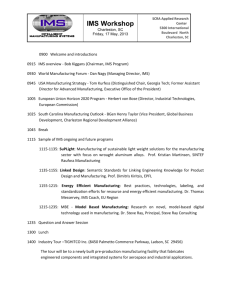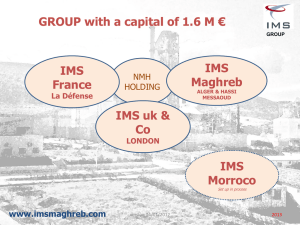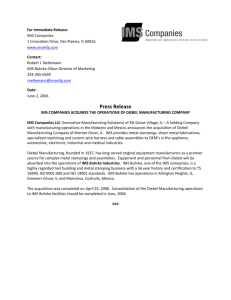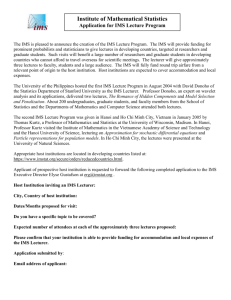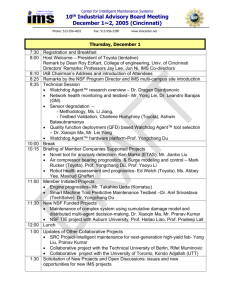Hierarchical (IMS) (late 60s-70s)
advertisement
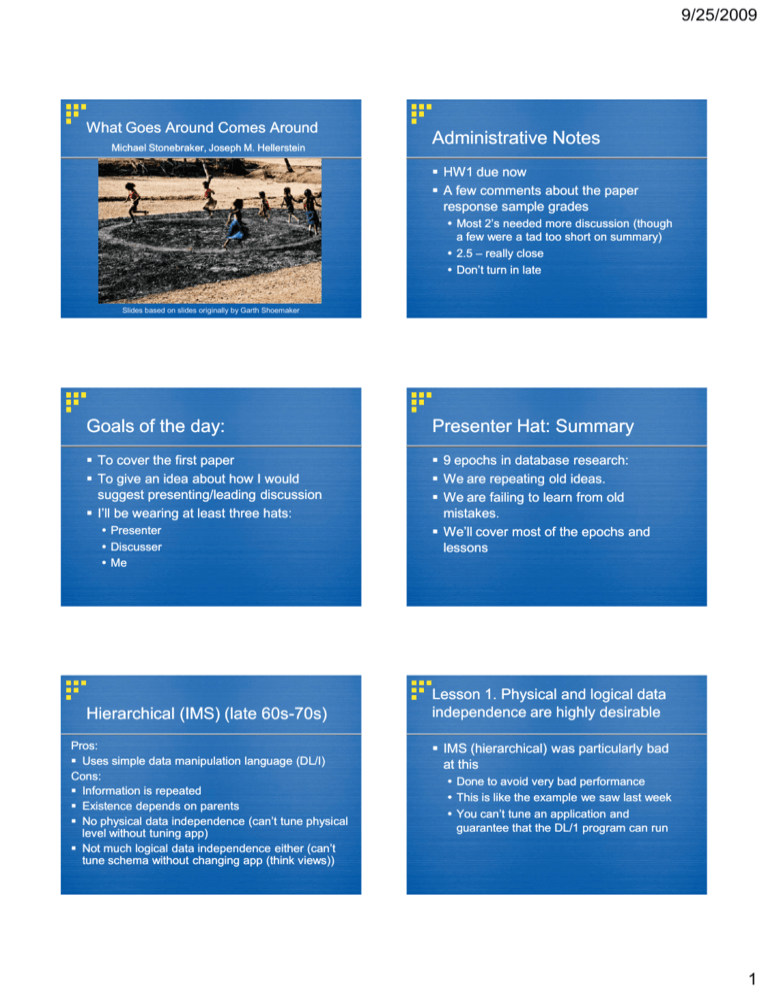
9/25/2009
What Goes Around Comes Around
Michael Stonebraker, Joseph M. Hellerstein
Administrative Notes
HW1 due now
A few comments about the paper
response sample grades
Most 2‟s needed more discussion (though
a few were a tad too short on summary)
2.5 – really close
Don‟t turn in late
Slides based on slides originally by Garth Shoemaker
Goals of the day:
Presenter Hat: Summary
To cover the first paper
To give an idea about how I would
suggest presenting/leading discussion
I‟ll be wearing at least three hats:
9 epochs in database research:
We are repeating old ideas.
We are failing to learn from old
mistakes.
We‟ll cover most of the epochs and
lessons
Presenter
Discusser
Me
Hierarchical (IMS) (late 60s-70s)
Pros:
Uses simple data manipulation language (DL/I)
Cons:
Information is repeated
Existence depends on parents
No physical data independence (can‟t tune physical
level without tuning app)
Not much logical data independence either (can‟t
tune schema without changing app (think views))
Lesson 1. Physical and logical data
independence are highly desirable
IMS (hierarchical) was particularly bad
at this
Done to avoid very bad performance
This is like the example we saw last week
You can‟t tune an application and
guarantee that the DL/1 program can run
1
9/25/2009
Lesson 2. Tree structured data
models are very restrictive
Lesson 3. It’s a challenge to provide
sophisticated logical reorganizations of tree
structured data
Information is repeated
IMS allowed 2 tree-structured
databases to be combined
You have to have a single parent, so
sometimes you have to duplicate
Existence depends on parents
What do you do if there is no parent value?
Directed Graph (CODASYL) (70s)
Pros:
Yeah! Graphs, not trees!
Can model many-to-many relationships
Cons:
Still no physical data independence
Much more complex than IMS
Handy thing to do, but…
Created a separate “view”, and views were
handled differently for users (a real pain)
Mapping the view to other databases was
very, very challenging
Lesson 6: Loading and recovering directed
graphs is more complex than hierarchies
Independence:
In IMS, each database could be
independently loaded from a source
In CODASYL, it‟s all connected, so
everything had to be loaded at once
Need to think carefully about disk seeks
(no general loading utility)
Discussion
Relational
(70s-early 80s)
Do you think structuring your data as a
graph instead of a tree is inherently
too complicated, or does this seem
like an implementation issue?
The proposal in a nutshell:
Store the data in a simple data structure
Access through a high level set-at-a-time
DML
No need for a physical storage proposal
Lots of good arguing by various sides “the great
debate”
2
9/25/2009
Lesson 9: Technical debates are usually settled
by the elephants of the marketplace, and often
for reasons not related to technology
Lesson 10: query optimizers can beat all
but the best record at a time DBMS
application programmers
What really brought down IMS?
Surprising at the time, but true
IBM had both IMS and DB/2
IBM put DB/2 on VAX, but IMS on
mainframes
Mainframes had most of the DB market
They tried to implement DB/2 on top of IMS
and failed (complexity of IMS)
Releasing DB/2 and IMS for mainframes
Curtains for IMS
Like playing chess – the computer can
think of many more options than a human,
even if not all
Also similar to compilers
Entity-Relationship (70s)
Extended Relational (80s)
Response to normalization
Standard wisdom: create table, then
normalize. Problems for DBAs:
How many features can relational databases
have…
1. Where do I get initial tables
2. Can‟t understand functional dependences
Lesson 11: Functional dependencies
are too difficult for mere mortals to
understand. Another reason for KISS
Set valued attributes
Aggregation
Generalization
And many, many more
Lesson 12: unless there is a big performance or
functionality advantage, new constructs will
go nowhere
Semantic (late 70‟s and 80‟s) (SDM)
Discussion
Similar ideas, but more radical; change
whole model to be semantically richer.
Lots of machinery, little benefit. Died
without a trace.
The last two epochs didn‟t make much
lasting impact. Were they worth doing?
Why or why not?
3
9/25/2009
Object-oriented
(late 80‟s and early 90‟s)
+Support OO languages
-market failure: no leverage, no standards,
some versions had reliance on C++
Object-Relational
(late 80s and early 90s)
OO + R
+ Some commercial success
+ put some code in DBMS
- no standards
Lesson 13: Packages will not sell to
users unless they are in “major pain”
Absence of leverage – not good enough
to just not have to write a load and
unload program
No standards
No programming language Esperanto –
if you had any program not written in
C++, it wouldn‟t work
Lesson 15: Widespread adoption of new
technology requires either standards and/or an
elephant pushing hard
Discussion hat: this is an interesting
statement. Given that Stonebraker is the
person behind the technology that they‟re
claiming had the biggest success in this
epoch, how un-biased is he likely to be?
While (as I said) all major DBMSs have some
OO features (e.g., stored procedures), that‟s
not as much as proposed in OR space.
Lesson 15: Widespread adoption of new
technology requires either standards and/or an
elephant pushing hard
Lesson 15: Widespread adoption of new
technology requires either standards and/or an
elephant pushing hard
Discussion hat: this is an interesting
statement. Given that Stonebraker is the
person behind the technology that they‟re
claiming had the biggest success in this
epoch, how un-biased is he likely to be?
Further discussion: most papers are written
by their chief proponents. How unbiased are
they likely to be?
Discussion hat: this is an interesting
statement. Given that Stonebraker is the
person behind the technology that they‟re
claiming had the biggest success in this
epoch, how un-biased is he likely to be?
Further discussion: most papers are written
by their chief proponents. How unbiased are
they likely to be?
Even further discussion: how should this
impact how you read papers?
4
9/25/2009
XML (late 90s to - ?)
Semantic heterogeneity
Schema later: best for semi-structured
apps… authors claim there aren‟t many of
these
XML Schema:
Can be hierarchical, as in IMS
Can link to other records as in CODASYL & SDM
Can have set-based attributes as in SDM
Can inherit from other records, as in SDM
Even more complexity!
Three visions of the future of
XML Schema:
XML schema fails because of excessive complexity
A “data-oriented” subset of XML Schema will be
proposed that is vastly simpler
“It will become popular. Within a decade, all problem
with IMS and CODASYL that motivated Codd to
invent the relational model will resurface. At that time
some enterprising researcher, call him Y, will „dust
off‟ Codd‟s original paper, and there will be a replay
of „the Great Debate‟ Presumably it will end the same
way as the last one. Moreover, Codd won the Turing
award in 1981 for his contribution. In this scenario, Y
will win the Turing award circa 2015”.
Discussion:
The authors suggest three possible
outcomes for XML schema:
Failure
Subset adopted
XML Schema becomes dominant, and we
start the whole cycle again
Lesson 17: XQuery is pretty much
OR SQL with a different syntax
As mentioned last week:
OQL (OO)
UnQL (unstructured)
StrUQL (semi-structured)
XMLQL (XML)
XQuery (XML)
Added bonus. XQuery and SQL share
a common inventor: Don Chamberlain
Discussion (from WebCT)
Are we really circling around?
New data models learn from old ones
Will there always be a universal data
model?
Lesson 18: XML will not solve semantic
heterogeneity either inside or outside the
enterprise
We haven‟t seen a whole lot of this yet,
but we‟ll see more when we get to Data
Integration
Which one of these do you think is most
likely, and why?
5
9/25/2009
Discussion & Me Hat:
Example that’s not great
The authors claim that XML still doesn‟t
solve the semantic heterogeneity
problem.
What is the semantic heterogeneity
problem?
What is missing from the XML approach?
Meta comments (me hat)
Discussion
Don‟t leave it until the end
Can be related to both papers
Should not be about “right” answer
Keep questions short and easy to understand
Look at WebCT posts
Didn‟t discuss all details – even left some
big chunks out
I‟ll give you a list of things not to skip
Lesson 4. Record-at-a-time user interface
forces manual query optimization (hard!)
Sample query: “Get unique Supplier
(sno = 16)
Until no-more{
Get next within parent (color =red)}
In contrast:
SELECT distinct *
FROM supplier
WHERE …
Average IMS query took 17 test runs!
Lesson 7: Set-at-a-time languages are good;
offer improved physical data independence
Lesson 5: Directed graphs are more flexible
than hierarchies, but more complex
IMS users keep track of:
Current position in DB
Parent
CODASYL users keep track of:
Last record touched by app
Last record of each record type touched
Last record of each set type touched
Lesson 8: logical data independence is easier with a
simple data model than with a complex one
6
9/25/2009
Lesson 14 (1): Persistent languages will
go nowhere without support of PL
community
Lesson 14: OR puts code in DB
which makes for fast adaptability
PL folks have consistently refused to
focus on I/O (and DB)
No built in functionality
Problematic to do this programming
User-defined data types
User-defined operators
User-defined functions
User-defined access methods
Lesson 16: Schema-later is
probably a niche market
7
